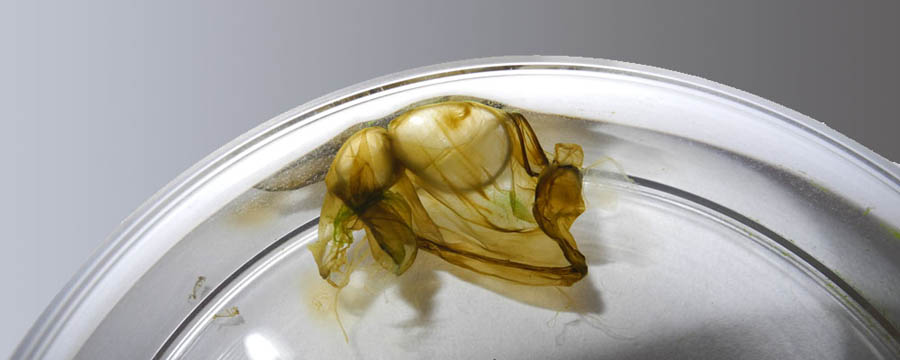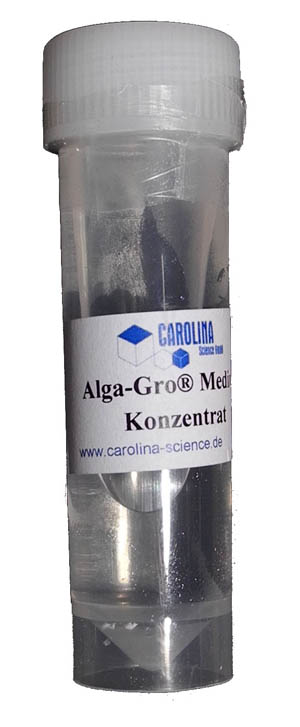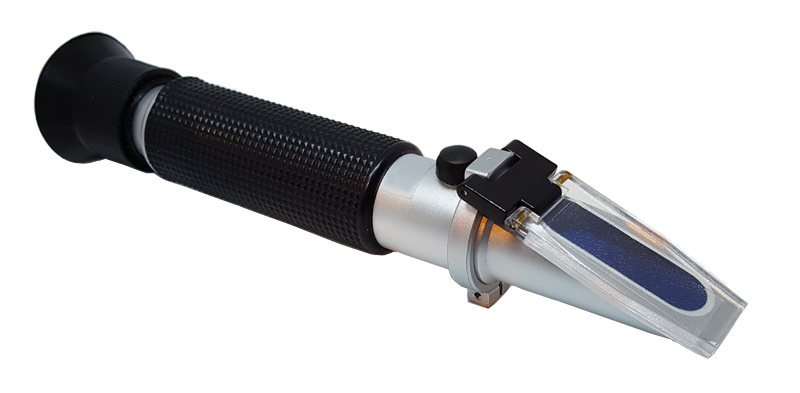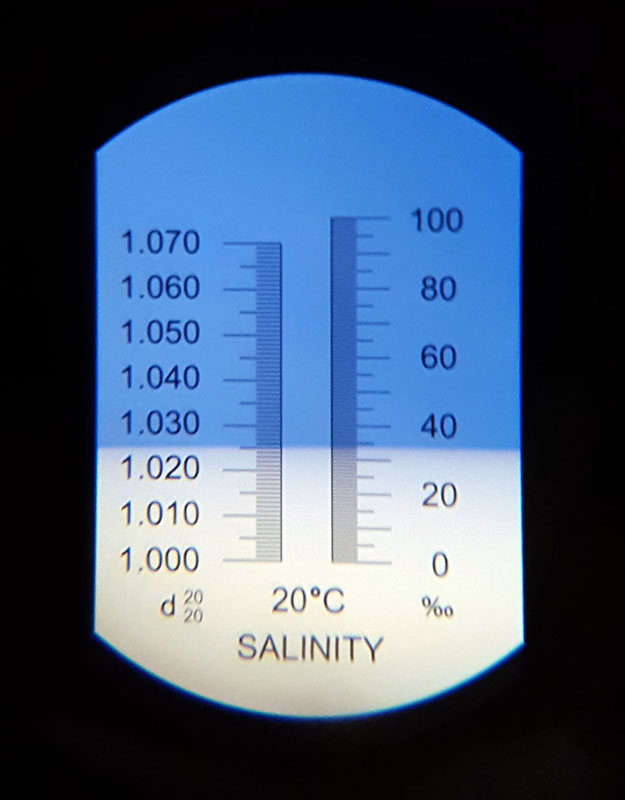
Biofilm with gas bubbles (oxygen), which becomes detached from the bottom of the petri dish. This biofilm consists of diatoms and mucilage extruded by the diatoms.
Nutrient solution
Diatoms can be cultivated in water or on agar. Agar is often used for the raw culture, because the diatoms which have reproduced on it can easily be isolated. For unknown reasons, we were not successful in cultivating on agar. For the observation of diatoms in the culture vessel, water is preferable, because mechanical devices can be used for observation in the culture vessel and the environment is more natural. In particular, there is no additional reduction in the mobility of the diatoms in water.
In cultivation, diatoms are transferred into a suitable nutrient solution. Apart from water, this medium typically consists of various salts, vitamins, trace elements, phosphate, nitrate and silicate. Marine salt is to be added in case of marine diatoms. Often in recipes soil extract is included, which in my opinion is also a concession that the ideal ingredients are not exactly known.
Procurement
One can produce nutrient solutions according to classical or modern recipes by themselves. A variety of recipes for algae in general and diatoms in particular for both freshwater and seawater can be found in "Algal Culturing Techniques" (Robert A. Andersen [Editor], Academic Press). It is more convenient to purchase ready nutrient solutions on the market. They are obtained as a medium ready to be used or in the form of a stock solution or a powder.
As we were mainly concerned with cultivating some larger species from local waters, we did not bother to search for media suitable for diatoms that are difficult to cultivate. For enthusiasts of such species there are recipes in literature.
We usually use two commercially available media, which both have proven themselves:
two commercially available media, which both have proven themselves:
Alga-Gro® from Carolina Biological Supply Company (www.carolina.com). In Germany it is marketed by the subsidiary Carolina Science GmbH (www.carolina-science.com). The composition of Alga-Gro has not been released. Silicate for diatoms is included. Alga-Gro is available as a sterile medium ready for use or as a sterile concentrate (stock solution). If one wishes to limit the growth of the cultivated diatoms, one can, according to our experience, reduce the concentration by half as compared with the manufacturer's specification.

Cell-hi WP from Varicon Aqua Solutions Ltd (www.variconaqua.com). It is the well-known Walnes medium. Cell-hi WP is delivered as a powder ("all-in-one powder"). From this, either a stock solution (concentrate) or the finished medium is prepared by addition of water. Sodium metasilicate is added for diatoms in accordance with the manufacturer's instructions.
Varicon Aqua Solutions also provides Cell-hi F2P, which is based on the Guillard F/2 medium and differs from Walnes medium by other amounts of ingredients. Our first experiences show that for our cultivated species the media according to Walnes and Guillard are comparable well suited. However it is to be expected that the media differ in particular in their suitability for certain species, the duration of the lag phase, the achieved cell density and the growth rate. A comparison of the two media with respect to the duration of the Lag phase, the achieved cell density and the growth rate in Skeletonema sp.is given in Vivi Endar et. al (2012). However, the investigated alga is not a diatom.
Nutrient solution for marine diatoms
Enriched seawater is used for the cultivation of marine species.To reproduce the natural environment well, filter sterilized seawater is desirable. If this is not available, sea salt can be added, which is offered for aquariums.
Salinity
For successful cultivation, the salinity, i.e. the amount of salt dissolved in a body of water, must be adapted to the conditions at the location where the diatoms are found. For this purpose, it is necessary to measure the salinity of the nutrient solution, which can be done using different measuring methods:
- Measurement of the density with a hydrometer, also called an areometer (right picture). Here the immersion depth of a floating body is measured.
- Determination of the refractive index with the refractometer (see below picture of the instrument and view through the eyepiece of the refractometer).
- Measurement of the conductivity, which is proportional to the salinity of the water.
 |
 |
If only small volumes of nutrient solution are needed, a large (precise) hydrometer is less recommendable, because it requires a measuring cylinder with a volume of approx. 250 ml. A refractometer works with only a few drops of nutrient solution, which also allows monitoring the salinity of long-term cultures in small Petri dishes (increase of salinity by evaporation).
When measuring salinity, attention must be paid to temperature dependency. The few drops that are placed on a refractometer quickly take on the temperature of the refractometer. Since it is not the salinity but the refractive index that is measured, many refractometers have temperature compensation, so that the salinity can be displayed on the measuring scale.
Common hydrometers have a built-in thermometer. Tables are used for conversion to a reference temperature.
Conductance meters can also have automatic temperature compensation. In this case, conversion is made to a reference value of 25° C.
Note on the preparation of the medium
- Carolina recommends to combine the concentrated medium with Carolina spring water. Distilled or demineralized water is not recommended. We use the (relatively mineral-poor) mineral water Volvic®. Correspondingly, we use Cell-hi WP with Volvic®, even if this has an influence on the composition of the nutrient medium.
- After the nutrient solution has been prepared, its pH value (increase with KOH, decrease with HCl for example) and its salinity can be adjusted for marine species.
- It is recommended to filter the finished nutrient solution.
- To avoid contamination, the finished nutrient solution is autoclaved or at least pasteurized. The manufacturers provide recommendations for this.
- It is recommended to store opened containers of nutrients cool, dry and in the dark.
|
Marine diatoms of the species Bacillaria paxillifera, which were kindly provided to me by Matt P Ashworth (University of TX Austin) and originate from Florida.
The nutrient solution was f/2 according to Walnes with a salinity of 32 ppt.
At the time of recording, sampling was already 19 months ago, so that a strong shortening of the apical length occurred.
(4x time lapse) |
Vivi Endar , Sarjito, Johannes Hutabarat and Budi Prayitno, 2012. EFFECT OF USING GUILLARD AND WALNE TECHNICAL CULTURE MEDIA ON GROWTH AND FATTY ACID PROFILES OF MICROALGAE Skeletonema sp. IN MASS CULTURE. Journal of Coastal Development Volume 16, Number 1.





